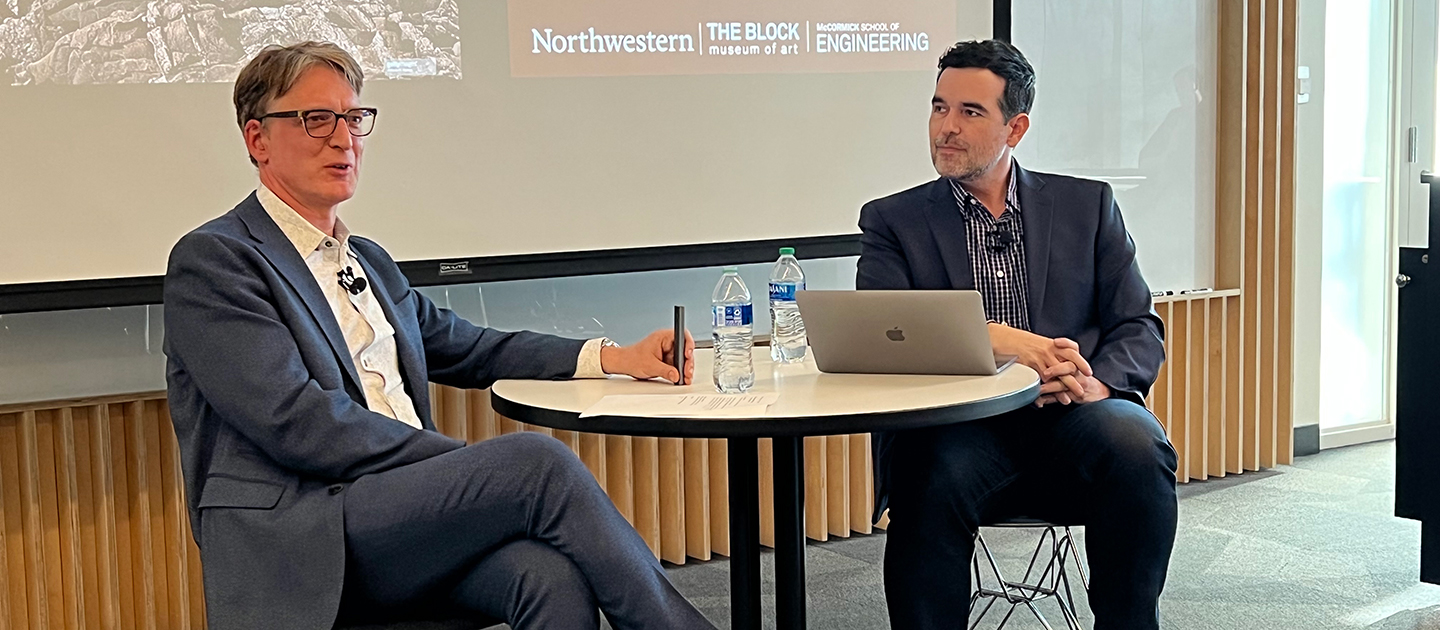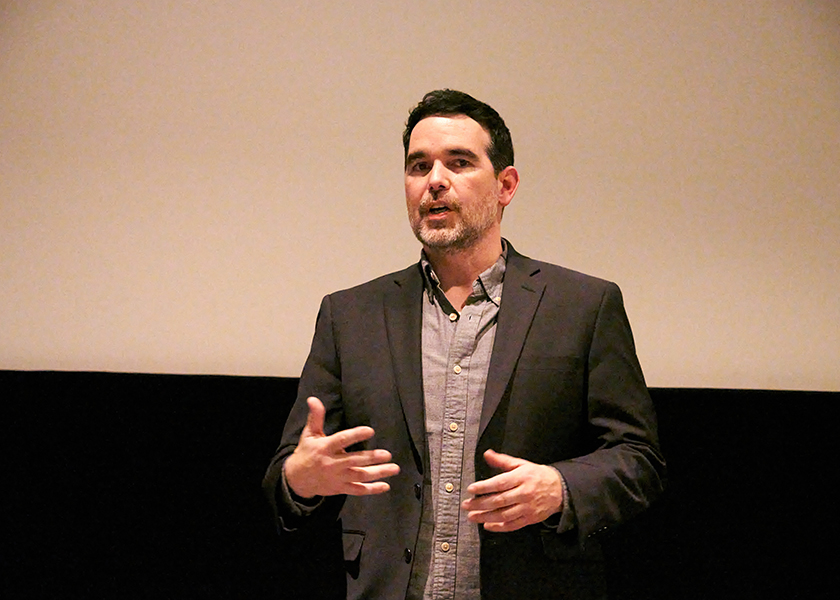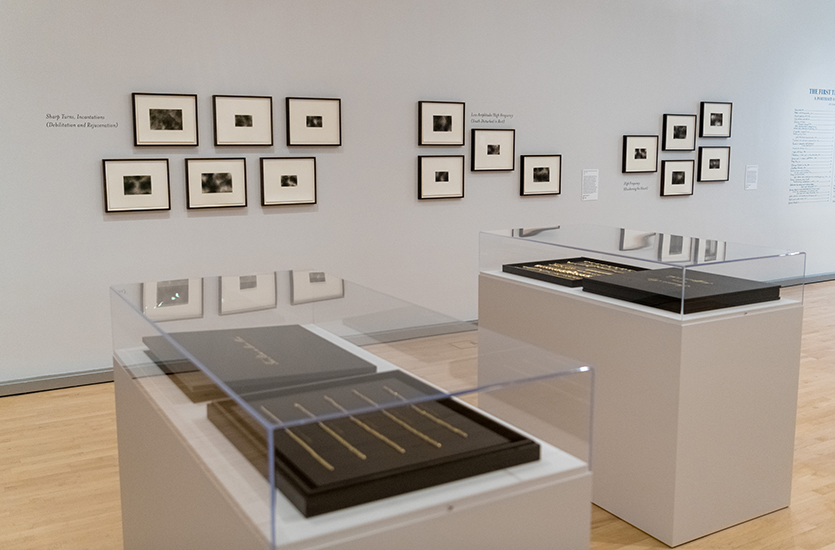 Events
EventsThe Common Ground Between Art and Science
Professor Malcolm MacIver and artist Dario Robleto spoke during an April 12 event

Northwestern Engineering’s Malcolm MacIver is as surprised as anyone to find himself studying the neural basis of empathy.

MacIver dropped out of school in the fourth grade for a mix of reasons that included having a learning disability and bullying. Because it was illegal for him to not be in school at that time, his family was forced to live on the fringes of society, eventually seeking refuge in an abandoned trapper shack in the middle of nowhere. The disconnection from society created a single-minded focus on survival that helped him eventually build a career as an academic scientist. For years, he focused on fundamental questions of how the nervous system works with little concern for how his work might impact society.
His focus began to change 2012, when MacIver and his wife Kristin welcomed their daughter Sasha. He remembers going to a movie theater around that time and seeing a St. Jude’s Hospital public service announcement. He immediately noticed something was different, welling up at the images of sick children.
“It was like I felt the hand of evolution strike through my cranium and replace the empathy chip with some big upgrade,” said MacIver, professor of biomedical engineering and mechanical engineering at the McCormick School of Engineering. “It was really at that time when I asked myself the same question every engineer and scientist asks when they have a child, which is ‘what can I do to make their future better?’”
The experience was part of a big change in the lab’s direction which is now fundamentally about how neural circuits to imagine different futures arose in the brain, including an important part of empathy—imagining the pain of other people—and how we might eventually extend the range of empathy to help meet existential challenges. He told his story during, “At the Limits of Life and Empathy,” a dialogue between MacIver and artist Dario Robleto, which explored how art and science both contemplate—and seek to overcome—the physical and temporal limits of human life.
“Yes, we might be working in different disciplines, use different language, have different tools, but we’re framing the same question at our core,” Robleto said. “We want to identify the obstacles that prevent us from becoming more empathetic beings, and we believe that our respective fields have the capability to turn the tide.”

This event, held April 12 at the Ford Engineering Design Center, was a collaboration between Northwestern Engineering and Northwestern’s Mary & Leigh Block Museum of Art. The discussion touched on the question of how art might provide a model for long-term thinking, especially in times of societal and ecological transformation.
An effective model—considering the challenges of climate change and looming food and water shortages—is desperately needed. MacIver’s group takes two different tracks: a longer-term effort to understand what the neural limits are for humanity to plan for far-off threats, and a more immediate effort that seeks socio-technical systems to help in the near future.
One example of work directed to the near future started in 2015.
Using the “rational irrationality” concept popularized by economist Bryan Caplan, that argues people won’t change their false beliefs if there’s no personal cost to holding them, MacIver wondered if he could make false beliefs about global warming costly. Working with Sandra Matz and Moran Cerf at Columbia University’s School of Business (Cerf was then at the Kellogg School of Management), MacIver conducted an 800-person study where 400 played a climate-prediction market, and the other half wagered on a sports and entertainment market.

The result: those who played the climate-prediction market increased their support for costly climate action such as increased taxes. Those in the sports and entertainment market experienced no significant change in climate-change interest. The work will be published in the coming weeks in Nature Climate Change.
Robleto, Northwestern Engineering’s Artist-at-Large, whose exhibition “The Heart’s Knowledge: Science and Empathy in the Art of Dario Robleto” is on display at the Block Museum through July 9, said MacIver’s research goes into unexpected and interesting places. Like the art traditions that Robleto values the most such as asking the biggest questions about our existence and the limits to our empathy, he sees a “similar, honest reckoning” with humanity’s limitations in what MacIver does.
More positively, Robleto recognizes that MacIver sees humanity’s possibilities.
“[Malcolm] is concerned, and I would even say pained, because I don’t think you can do this type of work without certain existential humanist sensitivities,” Robleto said. “I think he is asking questions that our poets and philosophers and artists understand very well: how do we negotiate between the gap of who we are and who we want to become? How do we counter the tragic ways time and distance can erode our sense of love and connection and empathy? And what is our moral responsibility to decrease the suffering of others and increase the well-being of not only our children, but of people we’re never going to meet and in the future we’re not going to be alive to experience?”